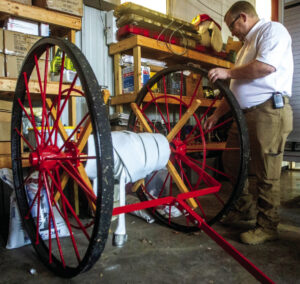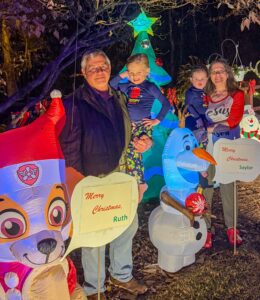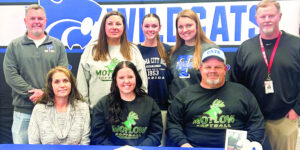$211K grant funds chest compression devices for VFDs
This past week saw efforts to attain increased life-saving capabilities for Franklin County come to fruition countywide.
The Franklin County Commission voted in August to approve a bid from Stryker for 14 LUCAS chest compression devices for the county volunteer fire departments for a total of $211,359.26 – just over $15,000 per device – to be paid for with a CDBG-CV grant.
The devices were distributed to the county volunteer fire departments during a Phil Campbell Rescue Squad meeting Sept. 14.
According to Stryker, the devices are described as delivering “high-performance, continuous chest compressions with less strain, micromanagement and risk for the caregiver.” Additionally, “the LUCAS chest compression system provides benefits both to the cardiac arrest patient and the resuscitation team.”
A company representative described the LUCAS device as a “simple machine that works very well.”
“They’re automatic CPR machines,” explained Franklin County EMA Director and Blue Springs VFD Chief Mary Glass. “It replaces the need for a person to perform CPR.”
Glass said CPR is an exhausting process; in contrast, the LUCAS automatic chest compression device is “constantly doing compressions in the amount that it’s supposed to and at the correct depth, thus providing more consistent assistance.”
Glass explained that any fire department accepting one of the devices would be agreeing to be paged out on cardiac calls. Each volunteer fire department that took charge of a LUCAS machine had to agree to a Memorandum of Understanding. Wording stipulates the device is to be used “as necessary during cardiac-related 911 calls in Franklin County” and that “failure to respond to these calls may result in termination of the MOU.”
“We’ve already had around five CPR calls this year,” said Hodges Fire Chief Leslie Cantrell, “and performing CPR really wears you out. These devices will be extremely beneficial for the firefighters as well as those in need of help.”
Cantrell explained CPR is performed in two-minute intervals, and in a recent call, a resident received eight rounds of CPR. “It’s very tiresome, and sometimes we have to do this during hot weather. You really have to get and keep the blood pumping and let the ambulance have time to get there so they can get the necessary drugs into their system.”
“I want to thank the commissioners and Rep. Jamie Kiel,” noted Glass. “Without their help, we would not have been able to acquire the necessary grant money to obtain these machines.”
Kiel, who was on hand for the Sept. 14 meeting, said the devices “could well mean the difference between life and death in an emergency situation.”
“Our volunteer firefighters are most often rural and don’t have access to immediate ambulance care,” he said. “Many of us live somewhere an ambulance might not be able to get to in time, and these devices will allow our volunteer firefighters to provide quicker life-saving care to the members of our community.”
“We appreciate our volunteer fire departments and the service they provide,” added Commission Chairman Barry Moore. “Every minute counts.”







